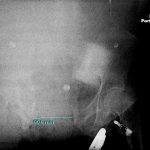What The Heck? The Answer
The photo on Friday shows a woman who had been run over by her own car. The vehicle had rolled over her pelvis and stopped, requiring extrication. The most likely injury is an open book pelvic fracture with significant diastasis and/or bilateral unstable sacral fractures.
If you see this clinical presentation there are several things you need to do immediately:
- Call for blood. Losses will be large, so you may even want to consider activating your massive transfusion protocol.
- Call an orthopedic surgeon. External stabilization will be needed to help decrease blood loss.
- Consider early intubation for control of pain. You will be doing a lot, and a patient in agony will slow you down. Your patient is already hypovolemic, so plan your drug choices accordingly.
- Search for evidence of an open fracture. Do a good rectal and vaginal exam looking for blood.
The pelvic xray is poor quality, but shows the major problem, a 10cm pubic diastasis from the open book pelvis fracture. Wrapping the pelvis may be of some help, but consult your orthopedic surgeon first. This pelvis is probably not connected to the spine anymore, so wrapping may have variable results.





